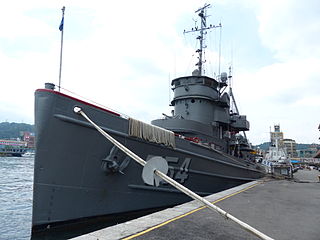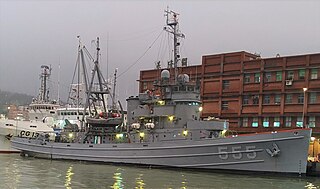
USS Achomawi (AT-148/ATF-148) was an Abnaki-class fleet ocean tugs in the service of the United States Navy, and was named for the Achomawi tribe of Native Americans.
USS Pakana (AT–108) was an Abnaki-class fleet ocean tug. It was named after the Pakana, a Native American tribe of Texas. This ship saw service in the Pacific theater of World War II, and was later transferred to the United States Bureau of Mines for use in Alaska before being deliberately sunk in 1975.

USS Atakapa (ATF-149) was an Achomawi class of fleet ocean tug. It was named after the Atakapa Native American tribe that once inhabited territory which is now southwestern Louisiana and southeastern Texas.
USS Tekesta (AT-93) was Navajo-class fleet tug built during World War II for the United States Navy. Shortly after being built, it was crewed by trained Navy personnel and sent into the Pacific Ocean to provide tug service to damaged ships in battle areas. For successfully performing this dangerous work, she was awarded four battle stars by the war's end.
The second USS Bluebird (ASR-19) was a Penguin-class submarine rescue ship in the United States Navy.

USS Strickland (DE-333) was an Edsall-class destroyer escort in service with the United States Navy from 1944 to 1946 and from 1952 to 1959. She was sold for scrapping in 1974.

USS Lipan (AT-85) was a Navajo-class fleet tug constructed for the United States Navy during World War II. Her purpose was to aid ships, usually by towing, on the high seas or in combat or post-combat areas, plus "other duties as assigned." She served in the Pacific Ocean during World War II and the Korean War. She was awarded two battle stars for World War II and four battle stars for the Korean War.

USS Narragansett (AT-88) was a Navajo-class fleet tug constructed for the United States Navy during World War II. Her purpose was to aid ships, usually by towing, on the high seas or in combat or post-combat areas, plus "other duties as assigned." She served in the Atlantic Ocean and, at war’s end, returned home with three battle stars to her credit.

USS Yuma (AT-94/ATF-94/T-ATF-94) was a Navajo-class fleet tugboat constructed for the United States Navy during World War II. She was the second U.S. Navy ship named for the Yuma tribe of Arizona.
USS LST-888 was an LST-542-class tank landing ship built for the United States Navy during World War II. Late in her career she was renamed Lee County (LST-888) – after counties in twelve Southern and Midwestern states, the only U.S. Naval vessel to bear that name – but saw no active service under that name.
USS Gear (ARS-34) was a Diver-class rescue and salvage ship acquired by the U.S. Navy during World War II. Her task was to come to the aid of stricken vessels.
USS Skimmer (AMCU-41/LCIL-1093) was an LCI(L)-351-class landing craft infantry built for the U.S. Navy for the task of landing troops in combat areas.

USS Wateree (ATF-117/AT-117) was an Abnaki-class fleet ocean tug acquired by the U.S. Navy during World War II. Wateree was sent to the western Pacific Ocean to perform towing services; however, during a typhoon, she was damaged beyond repair and lost, with eight crew members missing.

USS Loeser was a Buckley-class destroyer escort of the United States Navy, named in honor of Lieutenant Commander Arthur E. Loeser (1903–1942).
USS Arapaho (AT-68/ATF-68) was a Navajo-class fleet ocean tug which served the U.S. Navy during World War II with her towing services. She was assigned initially to support the U.S. Atlantic Fleet, and was eventually assigned to support Allied forces in the war zones of the Pacific Ocean, resulting in her crew returning home after the war with four battle stars to their credit.
USS Wallacut (YTB-420), later YTM-420, was a tug that served in the United States Navy from 1945 to 1947 and from 1950 to 1976.

USS Apache (AT-67/ATF-67) was a Navajo-class fleet tug, later fleet ocean tug, in commission in the United States Navy from 1942 to 1946 and from 1951 to 1974. She saw service in World War II, the Korean War, and the Vietnam War.

USS Avoyel (ATF-150) was an Navajo-class fleet tug built for the United States Navy during World War II. She was the only U.S. Naval vessel to bear the name.

USS Moctobi (ATF-105) was an Abnaki-class of fleet ocean tug. She served in World War II, Vietnam, and Korea, the last two of which she received battle stars. She was scrapped in 2012.

USS Jicarilla (ATF-104) was Abnaki-class tugboat during the World War II. The ship was later sold to Colombia as ARC Sebastián De Belalcázar (RM-73). Her namesake is a group of the Apache tribe found in the southwestern United States.











